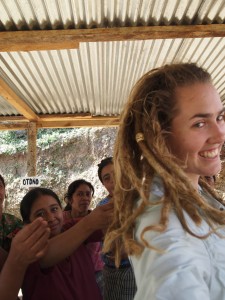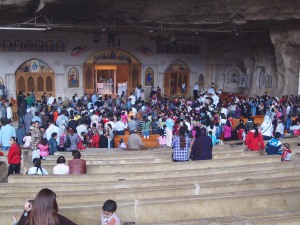Salaam aleikum! I just got back from strolling along the Nile (!!!!) and finally have the chance to write an update. Sorry for the long hiatus– SO MUCH has happened since my last posts that I don’t really know how to begin. Be prepared for some rambling and many bullet points.
Also, MAIL!! I don’t think I’ll have a mailing address in Egypt. But my family is coming to visit in two and a half weeks!! If you’d like to send me mail, you can send it to my home address (2162 Carroll Ave., St. Paul, MN 55104) and they’ll bring it to me. Just make sure you send it by December 15 or so. I’d be so happy to hear from you!!
Chapter One: Despedidas in Guatemala
-I presented the results of my interview study in Xeabaj II– the presentation was meant to be an empowering exercise in which the women would begin to think creatively and concretely about how their skills can be focused into a project. I was satisfied with how the presentation went on my end, but I admit that their response was disappointing. More than anything, it showed me just how deeply entrenched the women of Xeabaj II are in cycles of dependency and paternalistic NGO support. But I’m still very excited and hopeful to hear how things go for them in the future.
-Spent a week with Leti and Juana in Rabinal, doing workshops on medicinal plants and color combinations! I watched the facilitators work their magic and provided entertainment (i.e. weaving and having dreadlocks) for the women in Rabinal:
Juana at the medicinal plants workshop:
-Spent my last weekend in Guatemala at the beautiful natural waterpark that is Semuc Champey:
-Also managed to visit Safe Passage, an organization doing impressive work in Guatemala City’s garbage collecting community near the city’s enormous dump. I met the women of Creamos, who gave me an incredibly joyful welcome and taught me how to make colorful beads out of recycled paper. I wish I had found out about them earlier!
– I’m already missing: speaking Spanish, companeras at OB, and fresh tortillas (luckily, abundant cheap falafel and pita bread is lending me a culinary shoulder to cry on here in Egypt.) Adios, Oxlajuj B’atz’!!
Chapter Two: London
-Met up with Haverford friends for a long weekend in London, and had the BEST time gallivanting around the city. Fish and chips, ultimate, markets, modern art, all great– but more than anything, it was amazing to be among old friends for a little while. Shoutout/huge thanks to Jess, David, Jared and Ruben!!
-Things that produced culture shock: Tall people. Clean streets. Hot water. Fashion (I looked like a hobo). Also, for the first day or so every time I heard someone talk I looked over my shoulder expecting to see Hugh Grant or Keira Knightley.
Chapter Three: Siwa Oasis and the Western desert

Less than 24 hours after my arrival in Cairo, I decided to forget settling in, and instead embarked on an impromptu trip to Siwa Oasis with my childhood friend Laura and her friend Karim. EXCELLENT decision– not only was the desert beautiful, but I met great people and even made good contacts with handicraft groups there. Siwa is fascinating: it’s the westernmost oasis in Egypt, and until about 30 years ago it had very little contact with the outside world. Now, the community’s making a concerted effort to ensure that tourism develops in such a way that Siwa’s cultural integrity is preserved. In terms of women’s roles and dress, Siwa is very conservative– married women are completely covered (including face and hands) and it’s rare for women to hold jobs outside the home.
In this context, the women’s income-generating projects I visited were especially interesting. I visited a government-run craft center where 15 young unmarried women are paid 5 LE ($1) per day to make wool rugs, shirts and bags embroidered with Siwan motifs, and silver and brass jewelry. Married women work from their homes. After about an hour communicating in a mix of Arabic, English, sign language and laughter, the women told me I’m welcome to come back and spend time with them (I could learn silversmithing!!).
I also talked to Mona and Abdullah at the local organization Siwa Community for Development and Environmental Conservation, who told me more about how handcrafts fit into their idea of Siwa’s development. SCDEC is providing training to young people in the community who will be responsible for collecting and documenting the oasis’s cultural heritage, and leading awareness campaigns in the community. Support for the preservation of handcrafts techniques is part of their more holistic campaign to make sure that future generations see value in Siwa’s uniqueness.
We also spent a lot of time just exploring the hot and cold springs, salt lakes, ruins and the fantastically dramatic desert with our guide/new friend Sayed the champion dune rally racer (who also was incredibly helpful in introducing me to people at the various community groups). He let us ride on top of the Land Cruiser, and I’m convinced that that exhilarating feeling is the closest I’ll ever get to magic carpet riding.
Other highlights:
-Eating approximately 1/5 of a small goat, roasted Bedouin-style, after being invited to dinner at a fancy hotel with new friends encountered on our desert safari
-Solo overnight in the White Desert. Made a fire using wood scraps and camel dung (I would rock Survivor) and marveled at the hugeness of the sky and the strangeness of the landscape
-Met three awesome travellers: Juan, Sara and Thibaut. Sara and Thibaut are doing a travel project called Let’s Play Together, in which they travel around the world and play games with people everywhere they go. I spent a great evening with them and their infuriating but addictive puzzle games
-Feeling really captivated by the desert: the dunes, the rocks, the sun, the stars. Ahmed Fahkry, an anthropologist who worked in Siwa, wrote it well: “The desert is like the sea; the word gives the hearer a certain undefined thrill and fills his heart with a feeling of mystery.”
Chapter Four: Cairo
My three day trip to Siwa turned into an eight-day excursion, and honestly, part of me never wanted to leave the desert. But I was desperately in need of clean clothes, so I finally made it back to the metropolis. Cairo feels huge and concrete jungle-y to me after the towns and villages and green mountains of Guate and the stark western desert. I feel like a bumbling tourist with my minimal Arabic, but I’m learning words every day and looking forward to starting real lessons tomorrow. And Cairo is so fun to explore– I’ve been walking a lot, sometimes hopping on random buses and jumping off in new areas, and I’m beginning to get my bearings.
On Sunday, Laura and I visited St. Simeon Church in Coptic Cairo, a huge amphitheater built into a cliff face that’s carved with Biblical scenes and verses. To get to the church, we walked through the narrow streets of Moqattam, Cairo’s garbage village, which is home to a Coptic Christian population that makes its living by collecting and recycling the city’s waste. The service was fascinating: a booming sermon covering the noise of murmured conversations and kids scrambling around on the many rows of stone pews. Laura and I attracted a lot of curious looks and managed to totally botch the process of taking communion, to the very apparent disapproval of the priest. I hope I get to learn more about the Coptic Christians and their community within Cairo– relations between Christians and Muslims have been less than harmonious in recent years. (Also, interesting to compare the two urban garbage dumps I’ve visited within the month, and the communities they support.)
View over Moqattam. If you look closely, you can see goats (pigs were outlawed and slaughtered a few years ago in swine flu panic) eating organic trash on the rooftop on the right.
Somewhere in Moqattam’s maze is the Association for the Protection of the Environment, the organization that I wrote about in my original Watson proposal. APE is a project for women’s empowerment and income generation, and they make rugs and paper products out of recycled trash. They’ve proved very hard to get in touch with, but insha’allah I’ll be visiting them soon!
In the meantime, today I talked with the staff at Fair Trade Egypt, which works with 40 different artisan groups all over Egypt. They offered me an internship in product development and marketing here in their Cairo offices, which would provide me with a new experience of the more administrative end of fair trade, but would involve less contact with artisans in occasional visits to the groups. The women there are awesome, and it could be a great opportunity. FTE’s beautiful store:
Chapter Five: Decisions again
I remember thinking in Guatemala, when I was trying to decide what to do with my time there, that in my other countries I would have everything arranged when I got there. Ha! I guess I get two more tries with Mystery Country #3 and Indonesia, but my two weeks in Egypt have left me feeling decidedly undecided. I know that the Watson experience is partly learning how to deal with uncertainty and embrace spontaneity, so I’m trying to love the decision making process. Stay in Cairo with FTE and maybe APE? Go back to Siwa? Explore possibilities in other parts of Egypt? We shall see.
Thanks, intrepid readers. I always appreciate your thoughts and would definitely welcome advice on my new crop of decisions to be made.





















What a beautiful update! Your pictures, while I’m sure you feel they don’t do the desert full justice, are stunning and captivating. So impressed with you – and thanks for letting us have a glimpse into what you experience along the way….
Love, em
Woo hoo! So glad to have an update from you. Enjoy it all, cousin. We’ll send our little Christmas letter to your mom to hand-deliver 🙂
what lovely, strange and stark desert photos! if you are looking for feedback: your approach is just right: jump in, follow up on contacts, accept invitations, stay 8 days when you planned on 3, make friends, play games, take communion, learn new words, change direction, seize opportunities, repeat as necessary.